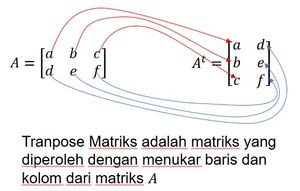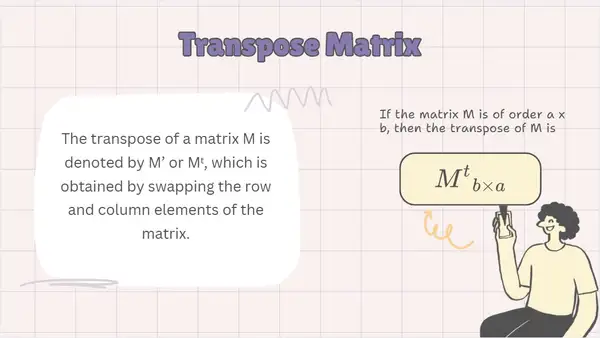Learn the concept of transpose and matrix similarity easily and completely. Find example questions and complete discussions to help you master class 11 mathematics material
A matrix is an arrangement of numbers arranged in rows and columns. Operations on matrices, such as addition, subtraction, multiplication, etc., have special rules.
Previously we learned about matrix concepts and types↝ . This time we will discuss transpose and similarity matrices.
1. Transpose Matrix (Transpose Matrix)
The transpose of a matrix $A$ of order $m \times n$ is a new matrix of order $n \times m$ which is obtained by swapping row elements into column elements and vice versa.
The transpose of a matrix $A$ is denoted by $𝐴^T$
For more clarity, look at the image below:
 Example:
Example:
If $A = \begin{bmatrix} 1 & 2 \\ 3 & 4 \\ 5 & 6 \end{bmatrix}$, then $A^T = \begin{bmatrix} 1 & 3 & 5 \\ 2 & 4 & 6 \end{bmatrix}$.
Properties of Matrix Transpose:
- $(A^T)^T = A$
- $(A + B)^T = A^T + B^T$
- $(kA)^T = kA^T$, where $k$ is a constant
- $(AB)^T = B^TA^T$
2. Similarity of Two Matrices
Definition
Two matrices $A$ and $B$ are said to be equal if and only if:
- The orders of matrices $A$ and $B$ are the same.
- The elements in the matrices $A$ and $B$ are the same.
Example:
Matrix $A = \begin{bmatrix} 1 & 2 \\ 3 & 4 \end{bmatrix}$ and $B = \begin{bmatrix} 1 & 2 \\ 3 & 4 \end{bmatrix}$ are the same matrix.
Sample Question
Given the matrix $P = \begin{bmatrix} 2 & -1 \\ 3 & 4 \end{bmatrix}$ and $Q = \begin{bmatrix} 1 & 2 \\ -3 & 4 \end{bmatrix}$. Determine:
- $P^T$
- $Q^T$
- $(P + Q)^T$
- Is $P$ the same as $Q$?
If $A$ is a matrix of order $3 \times 2$, determine the order of $A^T$.
Problem Solving
Known matrix:
- $P = \begin{bmatrix} 2 & -1 \\ 3 & 4 \end{bmatrix}$
- $Q = \begin{bmatrix} 1 & 2 \\ -3 & 4 \end{bmatrix}$
Asked:
- $P^T$
- $Q^T$
- $(P + Q)^T$
- Is $P$ the same as $Q$?
Solution ✍️
Finding $P^T$ and $Q^T$
To find the transpose, we convert rows into columns and vice versa.
- $P^T = \begin{bmatrix} 2 & 3 \\ -1 & 4 \end{bmatrix}$
- $Q^T = \begin{bmatrix} 1 & -3 \\ 2 & 4 \end{bmatrix}$
Finding $(P + Q)^T$
First, we add the matrices $P$ and $Q$:
$P + Q = \begin{bmatrix} 2+1 & -1+2 \\ 3-3 & 4+4\end{bmatrix} = \begin{bmatrix} 3 & 1 \\ 0 & 8 \end{bmatrix}$
Then, we find the transpose of the addition result:
$(P + Q)^T = \begin{bmatrix} 3 & 0 \\ 1 & 8 \end{bmatrix}$
Checking if $P$ is equal to $Q$
Two matrices are said to be the same if their order and elements are the same. We see that the matrices $P$ and $Q$ have the same order, namely $2 \times 2$. However, the elements are not all the same. So, $P$ is not the same as $Q$.
If $A$ is a matrix of order $3 \times 2$, determine the order of $A^T$.
Solution ✍️
If the matrix $A$ has 3 rows and 2 columns, then when it is transposed, the rows and columns will swap. So, the matrix $A^T$ will have 2 rows and 3 columns.
So, the order of $A^T$ is $2 \times 3$.
Extra Practice Questions
Given the matrix:
- $A = \begin{bmatrix}
1 & -2 & 3 \\
4 & 0 & -5 \end{bmatrix}$ - $B = \begin{bmatrix}
2 & 1 \\
-1 & 3 \\
0 & 2 \end{bmatrix}$
Determine:
- $A^T$
- $B^T$
- $(A + B)^T$ (note: the addition operation A + B cannot be performed because the order of the matrices is different)
- $(AB)^T$ (if AB matrix multiplication can be performed)
- $A = \begin{bmatrix}
1 & -2 & 3 \\
Given the matrix $C = \begin{bmatrix} x & 2 \\ 3 & y \end{bmatrix}$ and $D = \begin{bmatrix}4 & 2 \\3 & 1 \end{bmatrix}$. If $C = D^T$, determine the values of $x$ and $y$.
Prove that for every square matrix $A$, $(A^T)^T = A$ holds.
Given the matrix $E = \begin{bmatrix} a & b \\ c & d \end{bmatrix}$. If $E^T = E$, what kind of matrix is called a symmetric matrix? Give an example of a symmetric matrix of order $3 \times 3$.
Given the matrix $F = \begin{bmatrix}a & b \\-b & a\end{bmatrix}$. If $F^T = -F$, what kind of matrix is called a skew-symmetric matrix? Give an example of a skew-symmetric matrix of order $2 \times 2$.
